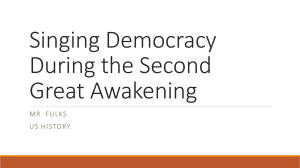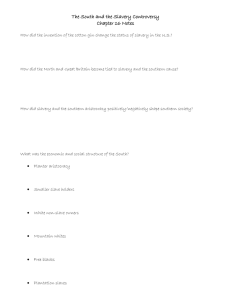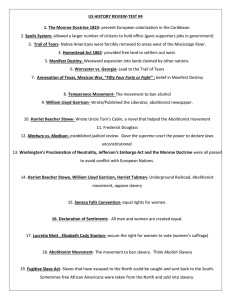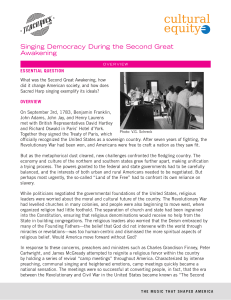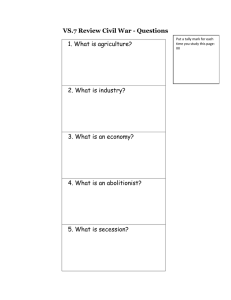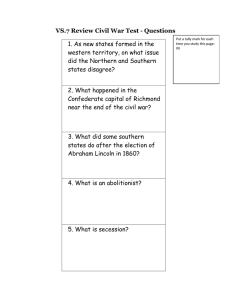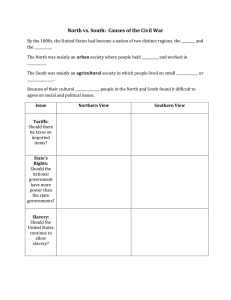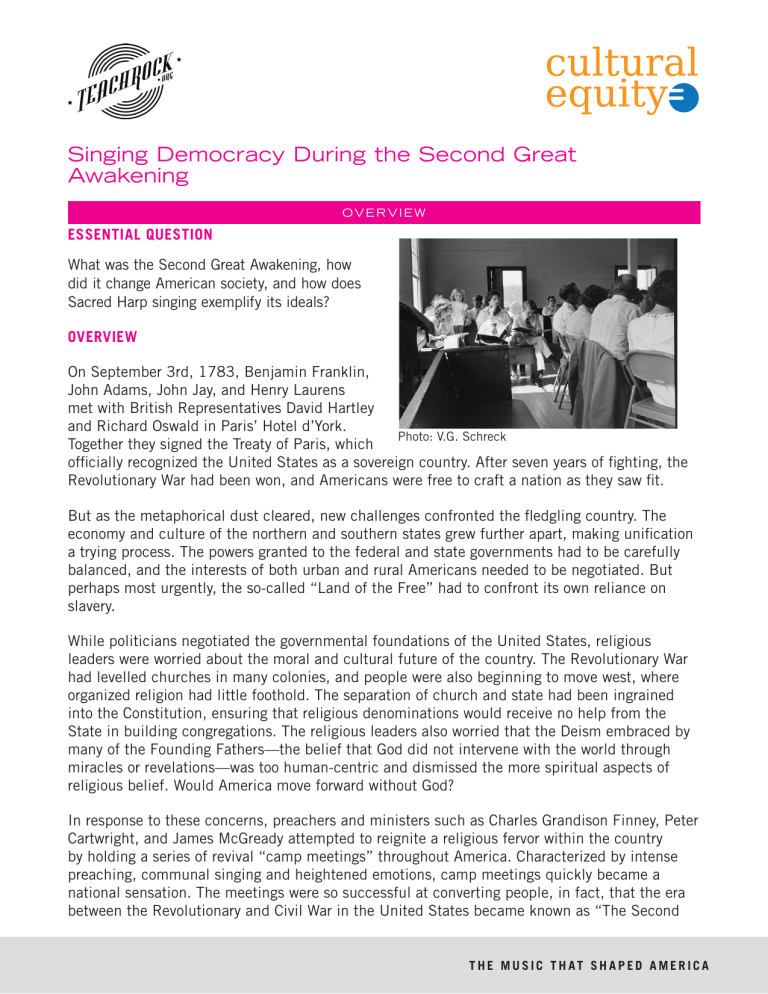
Singing Democracy During the Second Great Awakening OVERVIEW ESSENTIAL QUESTION What was the Second Great Awakening, how did it change American society, and how does Sacred Harp singing exemplify its ideals? OVERVIEW On September 3rd, 1783, Benjamin Franklin, John Adams, John Jay, and Henry Laurens met with British Representatives David Hartley and Richard Oswald in Paris’ Hotel d’York. Photo: V.G. Schreck Together they signed the Treaty of Paris, which officially recognized the United States as a sovereign country. After seven years of fighting, the Revolutionary War had been won, and Americans were free to craft a nation as they saw fit. But as the metaphorical dust cleared, new challenges confronted the fledgling country. The economy and culture of the northern and southern states grew further apart, making unification a trying process. The powers granted to the federal and state governments had to be carefully balanced, and the interests of both urban and rural Americans needed to be negotiated. But perhaps most urgently, the so-called “Land of the Free” had to confront its own reliance on slavery. While politicians negotiated the governmental foundations of the United States, religious leaders were worried about the moral and cultural future of the country. The Revolutionary War had levelled churches in many colonies, and people were also beginning to move west, where organized religion had little foothold. The separation of church and state had been ingrained into the Constitution, ensuring that religious denominations would receive no help from the State in building congregations. The religious leaders also worried that the Deism embraced by many of the Founding Fathers—the belief that God did not intervene with the world through miracles or revelations—was too human-centric and dismissed the more spiritual aspects of religious belief. Would America move forward without God? In response to these concerns, preachers and ministers such as Charles Grandison Finney, Peter Cartwright, and James McGready attempted to reignite a religious fervor within the country by holding a series of revival “camp meetings” throughout America. Characterized by intense preaching, communal singing and heightened emotions, camp meetings quickly became a national sensation. The meetings were so successful at converting people, in fact, that the era between the Revolutionary and Civil War in the United States became known as “The Second T HE MUSIC T H AT SH A P ED A MER ICA SINGING DEMOCR ACY IN THE SECOND GR E AT AWA K ENING Great Awakening,” the second time since the early 1700s that Americans embraced religion in large numbers. Music provided much of the time the energy and emotion that made camp meetings popular. Preaching was interspersed with collective hymn, and gospel singing which would spontaneously arise from the crowd. This singing was often repetitive and improvistary, and attendees would regularly add religious lyrics to popular melodies. Soon, the songs commonly sung during camp meetings were compiled into hymnbooks. Arguably the most famous of such books was The Sacred Harp, published by Benjamin Franklin White and Elisha J. King in 1844. Written using a shape-note system that made singing accessible to those without formal music training, the book was so popular that it become synonymous with a unique style of music. “Sacred Harp” singing continues to be performed to this day. The Second Great Awakening significantly altered the course of American politics and society. Through the camp meetings, Americans gradually turned away from a Calvinist mode of religious thought that privileged fate and predestination to an Arminian theology that stressed free will and personal moral responsibility. This turn in religious outlook helped create a generation of social activists who played seminal roles in the temperance, abolition, and suffrage movements that would continue into the 20th century. Set upon bringing the Earth into a closer alignment with Heaven, activist such as Lyman Beecher, the Grimké Sisters, Theodore Weld, and the Tappan brothers fought for a complete and unequivocal equality between the races and sexes—demands that many are still working towards today. In this lesson, created in partnership with the Association for Cultural Equity, students discover the causes, characteristics, and lasting effects of the Second Great Awakening by examining the biographies of historical figures associated within the movement. They also consider how Sacred Harp Singing represents the ideals of the Second Great Awakening by watching Alan Lomax’s ethnographic videos of a Sacred Harp performance. OBJECTIVES Upon completion of this lesson, students will: 1. KNOW (KNOWLEDGE): • The political and social landscape of Antebellum United States • The causes and historic effects of the Second Great Awakening • Sacred Harp Singing • Prominent religious figures and social activists during the Second Great Awakening, including Lyman Beecher, Charles Finney, Richard Allen, Nat Turner, Theodore Weld, Lewis Tappan, Elizabeth Cady Stanton, and Angelina Grimké 2. MASTERY OBJECTIVE: • Students will be able to recognize how the Second Great Awakening influenced American society and culture by analyzing footage of religious singing, and reading biographies of seminal figures in the movement. T HE MUSIC T H AT SH A P ED A MER ICA SINGING DEMOCR ACY IN THE SECOND GR E AT AWA K ENING ACTIVITIES MOTIVATIONAL ACTIVITY 1. Tell students that for this lesson they will be taking on the role of ethnographers—social scientists who study people in their own environments. Explain that they will be watching two videos of a musical performance, and as ethnographers they should practice what anthropologist Clifford Geertz called “thick description,” taking notes that detail the setting of the performance, the performer’s age, attire, body, body language, and anything else they notice. 2. Play Clip 1, “1982 Holly Springs Sacred Harp Convention: Abbeville (#33) with Prayer.” Then ask: • How would you describe the music featured in the video? Do the singers seem more professional or amateur? Are they performing for an audience? • Who seems to be leading this event? • Would you characterize this event as emotional? Why or why not? • How would you describe the people participating in the event? • What might be the function of this event? PROCEDURE 1. Tell students that the style of singing they saw in the video is called Sacred Harp singing, a unique form of American religious music. While the style has a long history, it became widely known as “Sacred Harp” music in the mid-1800s, during a period called “The Second Great Awakening.” This was a time of religious revival in the United States, when preachers across the country revitalized people’s interest in religion by hosting “camp meetings,” which were impromptu gatherings featuring music and preaching. 2. Pass out Handout 1 - Peter Cartwright’s Observation of the Cane Ridge Revival, telling students that this account describes one of the first camp meetings that occurred, in Cane Ridge, Kentucky. Have the class read the handout aloud, then ask: • Based on Cartwright’s account, how would you describe the atmosphere of a camp meeting? How does it compare to the video you watched? • Why might have the Presbyterian Ministers felt the need to organize one of these camp meetings? What do you think they hoped to attain from it? • In 1787, the Constitution was ratified, which enshrined the separation of church and state. How might have this contributed to the motivation behind the Cane Ridge Revival Meeting? Why might have one of the first camp meetings occurred in Kentucky, and not in one T HE MUSIC T H AT SH A P ED A MER ICA SINGING DEMOCR ACY IN THE SECOND GR E AT AWA K ENING of the original colonies? (Encourage students to consider Westward Expansion, the lack of established churches in what was the frontier at that time, the the harsh living conditions frontier life might entail.) • • What denomination started the Cane Ridge meeting, and which denominations joined in? How did the officials in the Kentucky synod treat the preachers who organized the Cane Ridge camp meeting? 3. Explain that one of the reasons Presbyterian Church officials might have been wary of the camp meetings had to do with the involvement of Methodists and Baptists, who had different views of Christianity than the Presbyterians. Show Image 1, “Calvinism versus Arminianism.” Ask students: • • What are the primary differences between Calvinism and Arminianism? Which seems to rely more on fate or predestination, and which on free will? How might adopting a more Arminian way of thinking influence one’s social actions? Might it spur someone to be more socially or politically active? Why? 4. Tell students that they will be looking at the ways camp meetings during the Second Great Awakening might have motivated religious leaders and social activists of the time. Break students up into groups, and pass out to each group one copy of Handout 2 - Café Conversation Activity. Have students follow the instructions on the handout. about one historical figure based on the Café Conversation (not the one presented in the paper they chose). After most of the eight historical figures in the handout have been discussed, ask students: • What do these historical figures have in common? What is different about them? • Was there one person in particular you found interesting or inspiring? Why? • What kind of arguments did these activists make in advocating for abolition, temperance, or women’s rights? • How did the events of the Second Great Awakening affect these figures? 6. Tell students they will be looking again at the Sacred Harp tradition. Play Clip 2, “Sacred Harp Singing,” and encourage students to think about connections between Sacred Harp singing at the Second Great Awakening. After the video, ask students: • In your own words, how would you describe Sacred Harp singing? • In what ways might Sacred Harp singing reflect the ideals of the Second Great Awakening? (Beyond its religious associations, encourage students to think about the ways Sacred Harp singing encouraged community, equality, and democracy). • Why do you think that feeling of “what’s lasting, true, and good” may have inspired social action during this period? 5. Ask students to share what they learned T HE MUSIC T H AT SH A P ED A MER ICA SINGING DEMOCR ACY IN THE SECOND GR E AT AWA K ENING SUMMARY ACTIVITY 1. Show Image 2, “Writing Prompt,” and have students follow the prompt given. Collect responses, or have students present their responses to the class. EXTENSTION ACTIVITY 1. Writing Prompt: While a very old tradition, Sacred Harp singing remains popular today. There are Sacred Harp summer camps, and groups in the Northern United States are taking it up again, regardless of their religious background. In today’s society, what might people find valuable or rewarding about Sacred Harp singing? 2. Writing Prompt: Despite calls for integration and equality by religious leaders going back to the Second Great Awakening, church services in many ways remain, as the Reverend Martin Luther King Jr. once lamented, “the most segregated hour of Christian America.” Research church segregation today, and summarize some contemporary projects that address the issue. T HE MUSIC T H AT SH A P ED A MER ICA SINGING DEMOCR ACY IN THE SECOND GR E AT AWA K ENING EXPLORE FURTHER Books: • Barry Hankins, The Second Great Awakening and the Transcendentalists (Greenwood Press) • Buell E. Cobb, Jr. The Sacred Harp: A Tradition and its Music (University of Georgia Press) • Harriet Beecher Stowe, Uncle Tom’s Cabin (Norton Critical Editions) Films: • Matt Hinton, Awake, My Soul: The Story of the Sacred Harp (Awake Productions) • Steven Spielberg, Amistad (Paramount) Records: • Various Artists, Awake My Soul (Official Soundtrack) and Help Me to Sing (Songs of the Sacred Harp) (Awake Productions) T HE MUSIC T H AT SH A P ED A MER ICA SINGING DEMOCR ACY IN THE SECOND GR E AT AWA K ENING S TA N D A R D S COMMON CORE STATE STANDARDS College and Career Readiness Anchor Standards for Reading (K-12) Reading 1: Read closely to determine what the text says explicitly and to make logical inferences from it; cite specific textual evidence when writing or speaking to support conclusions drawn from the text. Reading 6: Assess how point of view or purpose shapes the content and style of a text. Reading 8: Delineate and evaluate the argument and specific claims in a text, including the validity of the reasoning as well as the relevance and sufficiency of the evidence. Reading 9: Analyze how two or more texts address similar themes or topics in order to build knowledge or to compare the approaches the authors take. College and Career Readiness College and Career Readiness Anchor Standards for Writing (K-12) Writing 1: Write arguments to support claims in an analysis of substantive topics or texts using valid reasoning and relevant and sufficient evidence. Writing 7: Conduct short as well as more sustained research projects based on focused questions, demonstrating understanding of the subject under investigation. Writing 9: Draw evidence from literary or informational texts to support analysis, reflection, and research. College and Career Readiness Anchor Standards for Speaking and Listening (K-12) Speaking and Listening 1: Prepare for and participate effectively in a range of conversations and collaborations with diverse partners, building on others’ ideas and expressing their own clearly and persuasively. Speaking and Listening 2: Integrate and evaluate information presented in diverse media and formats, including visually, quantitatively, and orally. Speaking and Listening 3: Evaluate a speaker’s point of view, reasoning, and use of evidence and rhetoric. T HE MUSIC T H AT SH A P ED A MER ICA SINGING DEMOCR ACY IN THE SECOND GR E AT AWA K ENING NATIONAL CORE ARTS STANDARDS Responding Anchor Standard #7-Perceive and analyze artistic work. Anchor Standard #8-Interpret intent and meaning in artistic work. Anchor Standard #9- Apply criteria to evaluate artistic work. Connecting Anchor Standard #10-Synthesize and relate knowledge and personal experiences to make art. Anchor Standards#11-Relate artistic ideas and work with societal, cultural and historical context to deepen understanding. SOCIAL STUDIES – NATIONAL COUNCIL FOR THE SOCIAL STUDIES (NCSS) Theme 1: Culture Theme 2: Time, Continuity, and Change Theme 4: Individual Development and Identity Theme 5: Individuals, Groups, and Institutions NATIONAL STANDARDS FOR MUSIC EDUCATION Core Music Standard: Responding Analyze: Analyze how the structure and context of varied musical works inform the response. Interpret: Support interpretations of musical works that reflect creators’ and/or performers’ expressive intent. Evaluate: Support evaluations of musical works and performances based on analysis, interpretation, and established criteria. Core Music Standard: Connecting Connecting 11: Relate musical ideas and works to varied contexts and daily life to deepen understanding. T HE MUSIC T H AT SH A P ED A MER ICA SINGING DEMOCR ACY IN THE SECOND GR E AT AWA K ENING RESOURCES VIDEO RESOURCES • The Association for Cultural Equity - “1982 Holly Springs Sacred Hard Convention: ‘Abbeville (#33)’ with Prayer” • Sacred Harp Singing HANDOUTS • Handout 1 - Peter Cartwright’s Observation of the Cane Ridge Revival • Handout 2 - Café Conversation Activity T HE MUSIC T H AT SH A P ED A MER ICA Lesson Materials Image 1, “Calvinism versus Arminianism.” Image 2, “Writing Prompt” Handout 1 - Peter Cartwright’s Observation of the Cane Ridge Revival After attending a camp meeting, Peter Cartwright became a Methodist “Circuit Rider,” a preacher who traveled on horseback between many different congregations. In this account, he shares his observations of a camp meeting in Cane Ridge, Kentucky, one of the first camp meetings that later would become commonplace during the Second Great Awakening. Somewhere between 1800 and 1801, in the upper part of Kentucky, at a memorable place called “Cane Ridge,” there was appointed a sacramental meeting by some of the Presbyterian ministers, at which meeting, seemingly unexpected by ministers and people, the mighty power of God was displayed in a very extraordinary manner: many were moved to tears, and bitter and loud crying for mercy. The meeting was protracted for weeks. Ministers from almost all denominations flocked in from far and near. The meeting was kept up by night and day. Thousands heard of the mighty work, and came on foot, on horseback, in carriages and wagons. It was supposed that there were in attendance at times during the meeting from twelve to twenty-five thousand people. Hundreds fell prostrate under the might power of God, as men slain in battle. Stands were erected in the woods from which preachers of different Churches proclaimed repentance toward God and faith in our Lord Jesus Christ, and it was supposed, by eye and ear witnesses, that between one and two thousand souls were happily and powerfully converted to God during the meeting. It was not unusual for one, two, three, and four to seven preachers to be addressing the listening thousands at the same time from the different stands erected for the purpose. The heavenly fire spread in almost every direction. It was said, by truthful witness, that at times more than one thousand persons broke into loud shouting all at once, and that the shouts could be heard for miles around. From this camp-meeting, for so it ought to be called, the news spread through all the Churches, and through all the land, and it excited great wonder and surprise; but it kindled a religious flame that spread all over Kentucky and through many other states. And I may here be permitted to say, that this was the first camp-meeting ever held in the United States, and here our camp-meetings took their rise. As Presbyterian, Methodist, and Baptist ministers all united in the blessed work of the meeting, when they returned home to the different congregations, and carried news of this mighty work, the revival spread rapidly through the land; but many of the ministers and members of the synod of Kentucky thought it all disorder, and tried to stop the work. They called their preachers who were engaged in the revival to account, and censured and silenced them. These ministers then rose up and unitedly renounced the jurisdiction of the Presbyterian Church, organized a Church of their own, and dubbed it with the name of Christian. Handout 3 - Café Conversation Activity Instructions: 1. Spread out the following eight pages on a desk, face down, and have every member of the group choose one page at random (it’s ok if there are pages remaining). 2. Each group member has 8-10 minutes to read about the person on the page they chose. Try to memorize the person’s name, their biography, and their major accomplishments. 3. After everyone is done reading, hold a conversation, as if you were meeting each person in the group for the first time at a party. Role play as the historical figure featured on the page chosen. Introduce yourself to the others in the group, and try to hold a conversation while considering how the historical figure you are representing might talk and respond. 4. Be prepared to share what you learned about one person you talked to during the café conversation with the rest of the class. Name: Lyman Beecher Profession: Presbyterian Minister Dates: 1775-1863 Bio: Lyman Beecher was born in New Haven, Connecticut. He was raised by his uncle, who worked as a blacksmith and farmer. Beecher was an intellectually curious adolescent, and entered Yale University in 1793. After graduating, he studied at Yale Divinity School, and soon became an ordained minister. From there, Beecher worked in churches throughout New England before settling in Cincinnati, Ohio, in 1832. While Beecher did not participate in the camp meetings characteristic of the Second Great Awakening, he was involved in many of the social causes related to the revivals. He was a moderate abolishonist, and co-founded the American Temperance Society, which advocated against consuming alcohol. His sympathies with the evangelical Methodists and Baptists eventually led to charges of heresy by the Presbyterian Church in 1835, although he was eventually acquitted. Perhaps Beecher’s greatest accomplishment was the incredible legacy he left behind through his 13 children, many of whom became prominant social activists. His son Henry Ward Beecher would grow up to become a famous preacher and abolitionist who raised money to purchase and free slaves. Charles Beecher became a preacher and a composer of religious hymns who, like his father, was tried for heresy for his stance against slavery. Thomas Beecher became a preacher and often worked closely with prisoners. Edward Beecher was a theologian who helped establish the first anti-slavery society in Illinois. Isabella Beecher Hooker became a leader in the suffragist movement, while Catharine Beecher became a public education reformer who fought for women’s education and the incorporation of kindergarten in public schools. Arguably the most famous of Lyman Beecher’s children, though, was Harriet Beecher Stowe, the fierce abolitionist and author of the book Uncle Tom’s Cabin. Quote: “Earthly monarchs have their favorites...But God has no such favorites—He is no respecter of persons: He spared not the angels; and upon the earth distinctions of intellect, or wealth, or honor, will have no effect; he only that beliveth shall be saved. The great and the learned shall not be obtruded upon heaven without holiness because they are great or learned; and the humble and contrite shall not be excluded because they are poor, or ignorant, or obscure. God has provided a way for all men to return to Him.” -Lyman Beecher, “The Government of God Desirable” Name: Charles Grandison Finney Profession: Presbyterian Minister Dates: 1792-1875 Bio: Considered “the Father of Modern Revivalism,” Charles Finney was a practicing attorney in Connecticut until his conversion in 1821. He soon became a Presbyterian minister working mostly in western New York. His camp meetings in that area became so numerous and popular that they inspired other meetings, and soon western New York began to be referred to as the “Burned-Over District” in reference to the frequent “revival fires” that were happening there. In 1835, Finney moved to Oberlin, Ohio, to work as a minister and professor at the newly founded Oberlin College. In 1851, he became the president of the college—while still finding time to hold revivals. Finney’s success as a preacher is largely do to the “new measures” he developed for organizing revivals. Forgoing Calvinist ideas that God alone chose who would be converted to Christianity, Finney believed human beings were capable of cultivating an atmosphere that would allow conversions to occur. Following this belief, he developed methods that increased the emotional and spiritual energy of the revivals, and led to more conversions. He was also one of the first preachers to accept women into revivals, and because of this initiative, women in the United States began converting in large numbers, and increasingly taking on leadership positions. Finney was motivated throughout his career by his belief that conversions would lead to renewed efforts to create a more just society and bring about the kingdom of heaven on Earth. As such, Finney was a strong abolitionist, and under his leadership, Oberlin college was one of the first colleges in the country to enroll women and African Americans. Students and faculty in Oberlin also became very involved in the underground railroad. Quote: “Fallow ground is ground which has once been tilled, but which now lies waste, and needs to be broken up and mellowed, before it is suited to receive grain...To break up the fallow ground, is to break up your hearts—to prepare your minds to bring forth fruit unto God. The mind of man is often compared in the Bible to ground, and the word of God to seed sown in it, and the fruit represents the actions and affections of those who receive it. To break up the fallow ground, therefore, is to bring the mind into such a state, that it is fitted to receive the word of God. Sometimes your hearts get matted down hard and dry, and all run to waste, till there is no such thing as getting fruit from them till they are all broken up, and mellowed down, and fitted to receive the word of God. It is this softening of the heart, so as to make it feel the truth, which the prophet calls breaking up your fallow ground.” -Charles G. Finney, “How to Promote a Revival” Name: Richard Allen Profession: Methodist Minister Dates: 1760-1831 Bio: Richard Allen was born a slave in Philadelphia before moving to Dover, Delaware. As a slave he taught himself to read and write, and worked as a laborer, brick-maker, and wagon driver. At the age of 18, he was able to purchase his freedom. As a free man, he worked as a wagon driver and traveling preacher. He eventually settled back in Philadelphia, where he served as a Methodist minister at St. George’s Methodist Episcopal Church. Allen’s work at the church helped bring in large numbers of African Americans. Around 1790, Allen and his colleague Absolom Jones (another ex-slave) were praying at St. George’s when they were approached by a church official who who told them they were required to sit in separate pews reserved for African Americans. When Jones asked if he could finish his prayers before moving, he was physically pulled from the pew and forced into the segregated area. In response to this event, Allen and Jones led a Black exodus from St. George’s and formed their own worship communities. In 1787, they founded the Free African Society, a beneficial aid society that included a church and insurance company specifically for African Americans. In 1816, Allen founded the African Methodist Episcopal Church, and became the first Black Bishop in American history. Allen was a fierce abolitionist, and was a regular contributer to the country’s first black newspaper, Freedom’s Journal. The African Methodist Episcopal Church remains to this day, as does Allen’s influence towards giving African Americans a version of Christianity that they could claim as their own. Quotes: “I feel an inexpressible gratitude towards you who have engaged in the cause of the African race; you have wrought a deliverance for many from more than Egyptian bondage; your labours are unremitted for their complete redemption from the cruel subjection they are in. You feel our afflictions— you sympathize with us in the heart-rending distress, when the husband is separated from the wife, and the parents from the children, who are never more to meet in this world. The tear of sensibility trickles from your eye to see the sufferings that keep us from increasing. Your righteous indignation is roused at the means taken to supply the place of the murdered babe; you see our race more effectually destroyed than was in Pharaoh’s power to effect upon Israel’s sons; you blow the trumpet against the mighty evil; you make the tyrants tremble; you strive to raise the slave to the dignity of a man; you take our children by the hand to lead them in the path of virtue, by your care of our education; you are not ashamed to call the most abject of our race brethren, children of one Father, who hath made of one blood all the nations of the earth. You ask for this, nothing for yourselves, nothing but what is worthy the cause you are engaged in; nothing but that we would be friends to ourselves, and not strengthen the bands of oppression by an evil conduct, when led out of the house of bondage. May He who hath arisen to plead our cause, and engaged you as volunteers in the service, add to your numbers, until the princes shall come forth from Egypt, and Ethiopia stretch out her hands unto God.” -Richard Allen, “The Life, Experience, and Gospel Labors of Rt. Rev. Richard Allen” Name: Nat Turner Profession: Baptist Preacher/Revolutionary Dates: 1800-1831 Bio: Nat Turner led the largest and most violent slave uprising in American history. There are very few records detailing Turner’s life, his physical appearance is largely unknown, and historians continue to debate how much of his story is accurate and how much has become a legend. According to accounts, Nat Turner was born into slavery in Virginia. As a child he showed a great aptitude for learning, and excelled at biblical instruction provided to him by his master. In his 20s, Turner began having religious visions, and the fellow slaves he preached to began to consider him a prophet. Turner began to increasingly see himself as a liberator in the vein of Moses or Jesus, and in 1828 had a seminal vision which convinced him to stage a slave rebellion. On February 12, 1831, a solar eclipse occurred in Virgina, and Turner took the celestial event as a signal to begin preparations for the rebellion. On August 7th that year, another eclipse occurred and the sun appeared blue. Seeing this as the final signal, Turner and 70 other slaves began their revolt, killing whites across a 20 mile area. Turner’s goal was to inspire other slaves to revolt across the country. But this didn’t come to pass: Turner was caught on October 30, and executed on November 11. Turner’s rebellion divided the country. Abolitionists argued that Nat Turner’s rebellion was proof that the violence of slavery only begets more violence, while anti-abolitionists used the rebellion as an example of Black “savagery,” and promoted slavery as a “positive good.” Others became terrified of African Americans, forming mobs and killing twice as many blacks as Turner’s rebellion killed whites. Regardless of interpretation, Turner’s actions placed the institution of slavery in the forefront of people’s minds, just 30 years before the Civil War. Quotes: “I had a vision—and I saw white spirits and black spirits engaged in battle, and the sun was darkened—the thunder rolled in the Heaven, and blood flowed in streams—and I heard a voice saying, ‘such is your luck, such you are called to see, and let it come rough or smooth, you must surely bare it.’ By signs in the heavens that it would make known to me when I should commence the great work— and until the first sign appeared, I should conceal it from the knowledge of men—and on the appearance of the sign, (the eclipse of the sun last February), I should arise and prepare myself, and slay my enemies with their own weapons. And immediately on the sign appearing in the heavens, the seal was removed from my lips, and I communicated the great work laid out for me to do, to four in whom I had the greatest confidence.” -Nat Turner and Thomas R. Gray, “The Confessions of Nat Turner” Name: Theodore Dwight Weld Profession: Abolitionist writer and organizer Dates: 1803-1895 Bio: The son of Congregationalist minister, Weld spent much of his childhood working on the family farm in Connecticut. He studied at Hamilton College in Clinton, New York, where he became a disciple of Charles Finney. After spending two years helping Finney organize revivals, Weld became a student at Lane Theological Seminary, which was run by Lyman Beecher. A fierce abolitionist, while at Lane Seminary Weld hosted debates on slavery, helped organize an anti-slavery society at Lane Seminary, and found ways for seminary students to aid the black community in Cincinnati. After leaving Lane Seminary, Weld worked with Arthur and Lewis Tappan to found the American Anti-Slavery Society, which sent speakers throughout the country to lecture on the sinfulness of slavery. For the time, the society was considered radical, as it advocated immediatism, a stance created by abolitionist William Lloyd Garrison that demanded the immediate end of slavery and full political, social, and economic rights for African Americans. Preaching that slavery was a national sin, Weld incited a strong reaction, and became known as “the most mobbed man in America.” In 1838, he married fellow abolitionist speaker Angelina Grimké. At the wedding, Weld rejected his right to legal authority over his new wife. The wedding was attended by a interracial group of guests, and initiated a week long abolitionist celebration. Together with Angelina and her sister, Sarah, Weld wrote American Slavery As It Is, a seminal work in the abolition movement that sold over 100,000 copies its first year. Later they founded a racially integrated school in New Jersey. Quotes: “Is slavery, as a condition for human beings, good, bad, or indifferent? We submit the question without argument. You have common sense, and conscience, and a human heart;—pronounce upon it. You have a wife, or a husband, a child, a father, a mother, a brother or a sister—make the case your own, make it theirs, and bring in your verdict. The case of Human Rights against Slavery has been adjudicated in the court of conscience times innumerable. The same verdict has always been rendered— ‘Guilty;’ the same sentence has always been pronounced, ‘Let it be accursed;’ and human nature, with her million echoes, has rung it round the world in every language under heaven, ‘Let it be accursed. Let it be accursed.’ His heart is false to human nature, who will not say ‘Amen.’ There is not a man on earth who does not believe that slavery is a curse. Human beings may be inconsistent, but human nature is true to herself. She has uttered her testimony against slavery with a shriek every since the monster was begotten.” -Theodore Dwight Weld, “American Slavery As It Is: Testimony of a Thousand Witnesses” Name: Elizabeth Cady Stanton Profession: Woman’s Rights writer and organizer Dates: 1815-1902 Bio: Elizabeth Cady Stanton was born in Johnstown, New York. As a child, she poured over her lawyer father’s legal documents, discovering at an early age the few rights women had at that time. Her sense of injustice towards women continued through her schooling, where she realized she had far fewer options for education than her male siblings. Stanton ultimately enrolled in Troy Female Seminary in New York, where she was influenced by Charles Finney. However, unlike many others who attended Finney’s revivals, she remained skeptical of religion, which she thought also served to perpetuate gender inequality. In 1840, Stanton attended the World Anti-Slavery Convention in London, where she met Quaker minister, abolitionist, and feminist Lucretia Mott. The two became collaborators, and eight years later helped organize the Seneca Falls Convention, where they drafted the Declaration of Sentiments, which demanded equal rights for women. After the Seneca Falls Convention, Stanton continued to advocate for the rights of women, working closely with Susan B. Anthony. Stanton often wrote Anthony’s speeches, and together they published the periodical The Revolution. After the abolition of slavery, Stanton and the abolitionists parted ways, as Stanton demanded that women received the right to vote at the same time the right was given to African American men. Quotes: “The history of mankind is a history of repeated injuries and usurpations on the part of man toward woman, having in direct object the establishment of an absolute tyranny over her. To prove this, let facts be submitted to a candid world: He has never permitted her to exercise her inalienable right to the elective franchise; He has compelled her to submit to laws, in the formation of which she had no voice; He has taken from her all right in property, even to the wages she earns; In the covenant of marriage, she is compelled to promise obedience to her husband, he becoming, to all intents and purposes, her master; He has so framed the laws of divorce, as to what shall be the proper causes of divorce; He has monopolized nearly all the profitable employments, and from those she is permitted to follow, she receives but a scanty remuneration; He has denied her the facilities for obtaining a thorough education—all colleges being closed against her. . . In view of this entire disfranchisement of one-half the people of this country, their social and religious degradation,—in view of the unjust laws above mentioned, and because women do feel themselves aggrieved, oppressed, and fraudulently deprived of their most sacred rights, we insist that they have immediate admission to all the rights and privileges which belong to them as citizens of these United States. -Elizabeth Cady Stanton, “Declaration of Sentiments” Name: Lewis Tappan Profession: Philanthropist and Abolitionist Dates: 1799-1873 Bio: Lewis Tappan was born to devout Congregationalists in Northhampton, Massachusetts. His father was a shopkeeper, and as an adult Lewis moved to New York City with his brother, Arthur, to open a silk importation business. The business was very successful, leading the brothers to open a commercial-credit rating company. With their newfound wealth, the Tappan brothers retired early and devoted themselves to social causes. The brothers helped found the Anti-Slavery Society. They also provided financial support to Oberlin College, which provided integrated college education, and funded The Emancipator, an abolitionist newspaper. Lewis Tappan is perhaps best known for his role in the Amistad Case, which involved the fate of a group of Africans who overtook a slave ship that landed in Long Island, New York. Tappan created the “Amistad Committee,” which collected money to defend the Africans in court. He also arranged English tutors to educate the Africans as they awaited trial. Ultimately, the Africans triumphed in the Supreme Court. For the time, the Tappan brothers’ views seemed by many radical, even among abolitionists. They wanted an immediate end to slavery, advocated intermarriage, and refused to do business with those they felt were immoral. Arthur also founded the American Missionary Association, which pursued missionary work among fugitive slaves in Canada, the Ojibwe Tribe in Ohio, and among people in Jamaica and Sierra Leone. Quotes: “The slaveholders form a powerful landed aristocracy, banded together for the preservation of their own privileges, and ever endeavoring, for obvious reasons, to identify their private interests with the public welfare. The wealth and influence of your aristocracy, together with your own poverty, have led you to look up to them with a reverence bordering on that which is paid to a feudal nobility by their hereditary dependents. Hence it is, that, unconscious of your own power, you have permitted them to assume, as of right, the whole legislation and government of your respective States. We now propose to call your attention to the practical results of that control over your interests, which, by your sufferance, they have so long exercised. We ask you to join us in the inquiry how far you have been benefited by the care of your guardians, when compared with the people of the North, who have been left to govern themselves.” -Lewis Tapan, “Address to the Non-Slaveholders of the South” Name: Angelina Grimké Profession: Abolitionist and Woman’s Rights Leader Dates: 1805-1879 Bio: Unlike the majority of abolitionists active during the Second Great Awakening, Angelina Grimké was born in the south, part of a wealthy slave-holding family in Charleston, South Carolina. Grimké was described as rebellious from birth. She was known to question the authority of her father, and as a young adult, she shocked her Episcopal family by converting to Presbyterianism. Once converted, she began preaching to her family’s slaves, and grew increasingly uncomfortable with the institution of slavery. Her stance on abolition led to her expulsion from the Presbyterian church, and she then joined the Quakers, a group that had historically been strongly opposed to slavery. After some futile attempts to change Southerner’s minds about slavery, she moved with her sister, Sarah, to Philadelphia. Once in Philadelphia, Angelina became increasingly involved in the abolition movement, speaking at various conferences and publishing articles in abolitionist periodicals. Realizing that even in abolitionist circles, they retained less privileges than men, Angelina and Sarah began getting involved in women’s movements as well. As a woman and an abolitionist, Angelina received much hostility: rioters threw stones through windows during a speech she made in Pennsylvania Hall in Philadelphia, and she had to link arms with other women after the speech to leave without being harmed. Yet, she persisted, writing An Appeal to the Christian Women of the South, one of the seminal books about abolition. In 1838, Grimké married fellow abolitionist Theodore Dwight Weld. They lived with Sarah, and together helped write American Slavery As It Is: Testimony of a Thousand Witnesses. Quotes: “The great fundamental principle of Abolitionists is that man cannot rightfully hold his fellow man as property. Therefore, we affirm that every slaveholder is a man-stealer; a man, is a man, and as a man he as inalienable rights and he cannot rightfully be reduced to slavery. Our principle is that no circumstances can ever justify a man in holding his fellow man as property. Our immediate emancipation means, doing justice and loving mercy today—and this is what we call upon every slaveholder to do. I have seen too much slavery to be a gradualist. I say [the slaveholder] is able to let the oppressed go free. Oh, my very soul is grieved to find a northern woman thus ‘sewing pillows under all armholes,’ framing and fitting soft excuses for the slaveholder’s conscience, while with the same pen she is professing to regard slavery as a sin.” -Angelina Grimké, “Why Should Not All This Be Done Immediately?”
